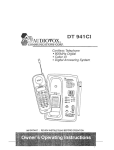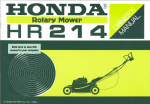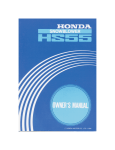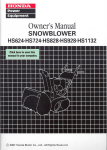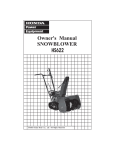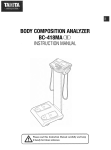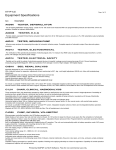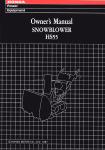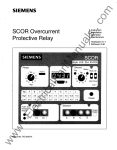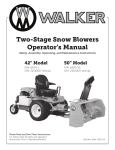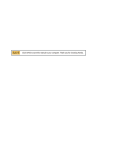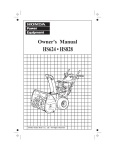Download Honda HS522 User's Manual
Transcript
Thank you for purchasing This manual snowblower. covers a Honda snowblower. the operation and maintenance of the HS522 All information in this publication is based on the latest product information available at the time of approval for printing. Honda Motor Co., Ltd. reserves the right to make changes at any time without notice and without incurring any obligation. No part of this publication may be reproduced without written permission. This manual should be considered a permanent part of the snowblower and should remain with the snowblower if it is resold. Pay special attention to statements preceded by the following words: A DANGER: Indicates tions are not followed. m instructions severe personal Indicates a strong are not followed. possibility CAUTION: 1ndicates.a possibility if instructions are not followed. injury or death will result if instruc- of severe personal of personal injury injury or death if or equipment damage NOTE: Gives helpful information. If a problem should arise, or if you have any questions about snowblower, consult an authorized Honda snowblower dealer. mm your Operating this equipment requires special effort to ensure the safety of the operator and the safety of others. Read and understand this Owner’s Manual before operating this equipment; failure to do so could result in personal injury or equipment damage. HONDA MOTOR CO., LTD. 1987, ALL RIGHTS RESERVED CONTENTS 1. SAFETY .............................................................................. WARNING LABEL LOCATION ................................................. SAFETY INFORMATION ........................................................ 2. COMPONENT IDENTIFICATION AND FUNCTION ....................... ENGINE SWITCH .................................................................. FUEL VALVE ........................................................................ CHOKE KNOB ...................................................................... STARTER GRIP .................................................................... THROTTLE LEVER (ENGINE SPEED) .......................................... SHIFT LEVER ....................................................................... CHUTE GUIDE ...................................................................... ................................... DRIVE CLUTCH LEVER ........................ AUGER CLUTCH LEVER ........................................................ HEIGHT ADJUSTMENT BOLT (TRACK MODEL ONLY) ................. SKID PLATE, SCRAPER ......................................................... ...................................... HANDLEBAR HEIGHT ADJUSTMENT 3. PRE-OPERATION CHECK ....................................................... . .................................................. FUEL LEVEL ...................... ENGINE OIL LEVEL ................................................................ 4. STARTING THE ENGINE ......................................................... . .......... ..:;. HIGH ALTITUDE OPERATION ....... . ...... . ................... . ............. . ............... 5. SNOWBLOWER OPERATION .................... 6. STOPPING THE ENGINE ........................................................ .. . ................................................................ 7. MAINTENANCE MAINTENANCE SCHEDULE ................................................... TOOL KIT ............................................................................ ENGINE OIL CHANGE ............................................................ SPARK PLUG SERVICE .......................................................... TRACK-ADJUSTMENT (TRACK MODEL ONLY) ......................... ........................................................................... STORAGE 8. .; .. 9. TROUBLESHOOTING ........................................................ .................................................................. SPECIFICATIONS 10. 11. WARRANTY SERVICE ........................................................... . .. : .2 3 3 4 6 8 8 9 9 10 10 11 11 12 12 13 13 15 15 17 18 20 21 23 24 24 25 26 27 28 29 32 33 34 .I. SAFETY WARNING LABEL LOCATION Read these labels before operating the snowblower. ENGINE \ IS RUNNING Honda snowblowers are designed to give safe and dependable service if operated according to instructions. Read and understand this Owner’s Manual before operating the snowblower. Failure to do so could result in personal injury or equipment damage. Before operating the snowblower, inspect the area in which you are going to clear snow. Remove debris and other obstacles the snowblower might strike or throw that may cause injury or damage to the snowblower. Inspect the snowblower before operating it. Repair any damage and correct any malfunction before operation. If you hit an obstacle while operating the snowblower, stop the engine immediately, and check for damage. Damaged equipment may increase the possibility of injury during operation. Do not use the snowblower when visibility is, poor. Under conditions of poor visibility, there is a greater risk of striking an obstacle or causing injury. Never use the snowblower to clear snow from a gravel road or driveway, as rocks may be picked up and thrown. They may cause injury to bystanders. Adjust the snow discharge chute to avoid hitting the operator, bystanders, windows, and other objects with thrown snow. Stay clear of the snow discharge chute while the engine is running. Children and pets must be kept away from the area of operation.to avoid injury from flying debris and contact with the snowblower. To avoid overturning, be careful when changing the direction of the snowblower while operating it on a slope. Do not use the snowblower to remove snow from roofs. The snowblower may overturn on, steep slopes if left unattended, causing injury to the operator or bystanders. 4 mEm l l l l l l l Know how to stop the snowblower quickly, and understand the operation of all controls. Never permit anyone to operate the snowblower without proper instruction. If people or pets suddenly appear in front of the snowblower while it is in operation, immediately release the auger and drive clutch levers to stop the snowblower and avoid possible injury from rotating auger blades. If the snow discharge chute becomes clogged, stop the engine and use a wooden stick to unclog. it. Never put your hand into the snow discharge chute while the engine is running: serious personal injury could result. Gasoline is extremely flammable and is explosive under certain conditions. Do not smoke or allow flames or sparks where the snowblower is refueled or where gasoline is stored. Refuel in a well-ventilated area with the engine stopped. Do not overfill the fuel tank, and make sure the filler cap is closed securely after refueling. Never run the engine in an enclosed or confined area. Exhaust contains poisonous carbon monoxide gas; exposure can cause loss of consciousness and may lead to death. The muffler becomes very hot during operation and remains hot for a while after stopping the engine. Be careful not to touch the muffler while it is hot. Let the engine cool before storing the snowblower indoors. Always make a pre-operation inspection (page 15) before you start the engine. You may prevent an accident or equipment damage. NOTE: While operating the snowblower, hold the handle firmly, and walk, don’t run. Wear suitable winter boots that resist slipping. . 5 2. COMPONENT IDENTIFICATOON AND FUNCTION WHEEL TYPE CHUTE- Y” 1 CHOKE KNOB AUGER AUGER CLUTCH LEVER CHUTE GUIDE I SH’FT tEVER I , DRIVE CLUidH LEVER 11 THROTTLE FUEL VALVE ENGINE OIL ,FILLER CAP \\ LEVER \ STARTER GRI ENGINE OIL DRhlN PI TRACK ENG!NE TYPE SWITCI CHOKE KNOB CHUTE ‘MUFFLER TRACK AUGER CLUTCH LE / SHIFT DRIVE Cl LUTCti LEVER CHUTE GUIDE / LEVER THROTTLE LEVER FUEL VALVE STARTER GRIP ENGINE OIL DRAIN/PLUG ENGIN\E OIL FILLER CAP 7 ENGINE SWITCH Use the engine switch to turn the ignition system ON for starting, STOP the engine. ENGINE and to SWITCH FUEL VALVE The fuel valve opens and closes the fuel line leading from the fuel tank to the carburetor. Make sure that the valve is positioned exactly at either the ON or OFF position. cmm Before transporting the snowblower, be sure to turn the fuel valve to OFF to prevent possible fuel leaks; spilled fuel or fuel vapor may ignite. 8 CHOKE KNOB Close the choke when the engine is cold or difficult to start. CLOSE STARTER GRIP Pull this grip to start the engine. STARTER GRIP .9 THROTTLE LEVER (ENGINE Use the throttle FAST position. SPEED) lever to select engine,speed. , In normal operation, SHIFT LEVER Use the shift lever to select drive speed or direction. 1: 2: N: R: LOW SPEED HIGH SPEED NEUTRAL REVERSE SHIFT 10 LEVER use the CHUTE GUIDE The chute guide controls the snow discharge angle and direction. Low and near DRIVE CLUTCH LEVER Use the drive clutch lever to propel or stop the snow blower. RIVE CLUTCH LEVER 11 AUGER CLUTCH LEVER Squeezing the auger clutch lever also operates the drive clutch lever; the snowthrowing mechanism starts and the snowblowei moves forward. Releasing the auger clutch lever stops both the snow-throwing mechanism and the forward motion of the snowblower. STOP \ AUGER HEIGHT ADJUSTMENT BOLT (Track CLUTCH model only) Use the bolt for adjusting the height and angle of the machine in relation to the tracks. Raise or lower the machine to the desired position. LOW MIDDLE HIGH : Hard snow or fine finish : Normal use : Dee’p snow or for transporting the snowblower. HEIGHT 12 ADJUSTMENT BOLT SKID PLATE, SCRAPER Adjust the skid plates and scraper for the auger housing ground clearance best suited to your snow removal conditions. (See page 14) HANDLEBAR HEIGHT ADJUSTMENT The handlebars can be set in the high, low or middle postion to suit the operator. To change handlebar height, remove the right and left adjusting bolts, align the bolt holes for the desired handlebar height, and reinstall the bolts. Tighten the nuts securely. HANDLEBAR ADJUSTING HEIGHT BOLT 13 Adjust the skid plate and scraper positions. m Before adjusting the skid plate and scraper positions, be sure to stop the engine and remove the spark plug cap from the spark plug. The skid plate and scraper have three adjusting positions. Select the position according to the surface conditions described in the chart. NOTE: Adjust the height equally on both sides. After adjusting the height, be sure to tighten the adjusting securely. bolts and nuts TO RAISE HEIGHT ADJUSTING BOLT (Track model only) SCRAPER Surface Conditions HEIGHT, ADJUSTING BOLT (Track model only) Scraper Skid Fresh snow over even ground MIDDLE Middle position Middle position Hard-packed snow over even ground UPPER Upper position Upper position Any snow over uneven ground LOWER Upper position Lower position 14 3. PRE-OPERATION CHECK mm disconnect To prevent accidental start-up, remove the engine switch key, and the spark plug cap before performing the pre-operation inspection. FUEL LEVEL Unscrew the fuel cap. Check the fuel level. Your engine is designed to use any gasoline that has a pump octane number ( R ‘2 M ) of 86 or higher, or that has a research octane number of 91 or higher. Gasoline pumps at service station normally display the pump octane number. We recommend that you use unleaded fuel because it produces fewer engine and spark plug deposits and extends the life of exhaust system components. Never use stale or contaminated gasoline or an oil/gasoline mixture. Avoid getting dirt, dust or water in the fuel tank. Use of a lower octane gasoline can cause persistent “pinging” or heavy “spark knock” (a metallic rapping noise) which, if severe, can lead to engine damage. If “spark knock” or “pinging” occurs at a steady engine speed CAUTION: under normal load;change brands of gasoline. If spark knock or pinging persists, consult your authorized Honda dealer. Failure to do so is considered misuse, and damage caused by misuse is not covered by Honda’s Limited Warranty. Occasionally you may experience light spark knock while operating under heavy loads. This is no cause for concern, it simply means your engine is operating efficiently. After refueling, be sure to tighten the fuel tank cap firmly. CAUTION: Don’t can cause stalling FUEL TANK let snow get in the fuel tank. and difficult starting. CAPACITY: 3.5 e (0.92 Water US gal, 0.77 FUEL FILLER in the fuel system Imp gal) OPENING 15 l l l l l Gasoline is extremely flammable and is explosive under certain conditions. Refuel in a well-ventilated area with the engine stopped. Do not smoke or allow flames or sparks in the area where the engine is refueled or where gasoline is stored. Do not overfill the fuel tank (there should be no fuel in the filler neck). After refueling, make sure the tank cap is closed properly and securely. ’ Be careful not to spill fuel when refueling. Spilled fuel or fuel vapor may ignite. If any fuel is spilled, make sure the area is dry before starting the engine. Avoid repeated oc prolonged contact with skin or breathing of vapor. KEEP OUT OF REACH OF CHILDREN. GASOLINES CONTAINING ALCOHOL If you decide to use a g’asoline containing alcohol (gasohol), be sure it’s octane rating is at least as high as that recommended by Honda. There are two types of “gasohol”: one containing ethanol, and the other containing methanol. Do not use gasohol that contains more than 10% ethanol. Do not use gasoline containing methanol (methyl or wood alcohol) that does .not also contain cosolvents and corrosion inhibitors for methanol. Never use gasoline containing more than 5% methanol, even if it has cosolvents and corrosion inhibitors. NOTE: l Fuel system damage or engine performance problems resulting from the use of fuels that contain alcohol is not covered under the warranty. Honda cannot endorse the use of fuels containing methanol since evidence of their suitability is as yet incomplete. l Before buying fuel from an unfamiliar station, try to find out if the fuel contains alcohol, if it does, confirm the type and percentage of alcohol used. If you notice any undesirable operating symptoms while using a gasoline that contains alcohol, or one that ‘you think contains gasoline that you know does not contain alcohol. 16 alcohol, switch to a ENGINE OIL LEVEL, Inspection: With the snowblower on a level surface, remove the oil filler cap and wipe the dipstick clean. Insert the dipstick into the filler neck, but do not screw it in. Remove the dipstick and check the oil level. If the level is low, fill to the top of the oil filler neck with the recommended oil. OIL FILLER NECK UPPER OIL FILLER b CAP AND LIMIT DIPSTICK OIL CAPACITY: 0.6 P (0.63 RECOMMENDED OIL: US qt. 0.53 Imp qt) Use high detergent, premium quality motor oil certified to meet or exceed U.S. automobile manufacturers’ requirements for service classification SE or SF (Motor oils classified SE or SF will show this designation on the container.) Select the appropriate oil viscosity for the average temperature in your area, as shown in the chart above. SAE 5W-30 is recommended for general, all-temperature use. CAUTION: l Engine oil is a major factor affecting engine performance and service life. Nondetergent oils and 2-stroke engine oils are not recommended because they have inadequate lubricating properties. l Running the engine with insufficient oil can cause serious engine damage. 17 4. STARTING iHE ENGINE Emm Never run the engine in an enclosed or confined area. Exhaust contains poisonous carbon monoxide gas; exposure can cause loss of consciousness and may lead to death. 1. Turn the engine switch to the ON position. ENGINE SWITCH / 2. Turn the fuel valve to the ON position. FUEL YALVE 18 3. In cold weather and when the engine is cold, move the choke to the CLOSE position. CLOSE 4. Pull the starter grip lightly until you feel resistance, CAUTION: l Do not allow the starter grip to snap back against gently to prevent damage to the starter. l Damage may result if the starter grip is pulled running. then pull briskly. the engine. while Return it the engine STARTER is GRIP 19 5. Let the engine warm up for several minutes. If the choke had been turned to the CLOSE position, return it gradually to the OPEN position as the engine warms up. CHOKE HIGH ALTITUDE KNOB OPERATION At high altitude, the standard carburetor air-fuel mixture will be excessively rich. Performance will decrease, and fuel consumption will increase. High altitude performance can be improved by installing a smaller diameter main fuel jet in the carburetor and readjusting the pilot screw. If you always operate the snowblower at altitudes higher than 6,000 feet above sea level, have your authorized Honda Snowblower dealer perform these carburetor modifications. Even with suitable carburetor jetting, engine horsepower will decrease approximately 3.5% for each 1,000 foot increase in altitude. The affect of altitude on horsepower will be greater than this if no carburetor modification is made. CAUTION: Operation of the snowblower at an altitude lower than the carburetor is jetted for may result in reduced performance, overheating, and serious engine damage caused by an excessively lean air/fuel mixture. 20 . -7 . 5. SNOWBLOWER OPERATION ram Before operating this equipment you stand the SAFETY information on page 4, 5. should read and under- 1. Move the throttle lever (p. 10) to the FAST position for normal operation. 2. Move the shift lever (p. 10) to select the desired drive speed. DRIVE SPEED WITH THROTTLE LEVER IN THE FAST POSITION Wheel 0.30 m/s 2 0.72 m/s R 0.72 m/s Speed is stated 1 type Track type (0.6 ft/s) 0.34 m/s (0.7 ft/s) (I .6 ft/s) 0.85 m/s (I .8 ft/s) (I .6 ft/s) 0.85 m/s (1.8 ft/s) in meters/second and (feet/second). CAUTION: l Be sure to disengage the drive clutch before shifting gears. l Be sure to set the shift lever into the groove. l Never move the shift lever while the snowblower is in motion. NOTE: l Low speed (1) is recommended for removing deep or hard-packed snow. l Track model only - Use the height adjustment bolt (p. 14) to adjust the height and angle of the snowblower. 3. Adjust the discharge chute. 4. Select the desired AUGER/DRIVE action: . SQUEEZE THE AUGER CLUTCH LEVER The snowthrowing mechanism starts and the snowblower moves forward. . SQUEEZE THE DRIVE CLUTCH LEVER ONLY The snowblower moves forward or backward, depending on the shift lever setting. . SET SHIFT LEVER IN NEUTRAL POSITION AND SQUEEZE THE AUGER CLUTCH LEVER. The snowthrowing mechanism starts and the snowblower remains stationary. 21 l l Adjust the snow discharge chute to avoid hitting the operator, bystanders, windows and other objects with thrown snow. Stay clear of the snow discharge chute while the engine is running. If the snow discharge chute becomes clogged, stop the engine and use a wooden stick to unclog it. Never put your hand into the snow discharge chute-while the engine is running; serious personal injury could result. f AUGER CLUTCH LEVER Squeeze to engage the snow blowing and driving mechanism DRIVE CLUTCH LEVER Squeeze to engage the drive mechanism NOTE: l Squeeze only the drive clutch when moving the snowblower to and from the area to be cleared. l If the snow is deeper than the height of, the auger, move the snowblower back and forth to remove snow gradually. l For maximum efficiency, clear snow before it melts then refreezes and hardens. 22 6. STOPPING THE ENGINE To stop the engine in an emergency, turn the engine switch OFF immediately. To stop the engine in normal circumstances: 1. Turn the throttle lever to the SLOW position and turn the engine switch to the OFF position. ENGINE SWITCH 2. Turn the fuel valve to the OFF position. FUEL VALVE 23 7. MAINTENANCE Periodic inspection and maintenance will help extend the service life of your HS522 Snowblower while keeping it in the best operating condition. Inspect or service as described in the table below. Shut off the engine before performing inspection and maintenance, and disconnect the spark plug wire from the plug so the engine cannot be started. If the engine must be run, make sure the area is well ventilated. Exhaust gas contains poisonous carbon monoxide; exposure can cause loss of consciousness and may lead to death. l l CAUTION: l To avoid overturning, place the snowblower on a level surface before performing inspection and maintenance. l Use only genuine HONDA parts or their equivalent. Replacement parts which are not of equivalent quality may damage the snowblower. MAINTENANCE SCHEDULE ITEM Engine oil Choke cable Auger clutch Check-Readjust Friction Fuel 1 Valve 1 Fuel NOTE: 24 disc disc Check rubber Check Check (Replace necessarvl line clearance tank and Everv Clean or 300 hrs 1 0 if Check-Readjust strainer 5 “ears Every 3 years (21 (1) (2) 1 (2) I 1 I Everv 5 vears or 300 hrs (21 Every 5 years or 300 hrs (21 (1) These parts may require more frequent inspection and replacement under heavy use. (21 These items should be serviced by an authorized Honda dealer, unless the owner has the proper tools is mechanically proficient. See the Honda Shop Manual for service information. (3) For professional commercial use, log hours of operation to determine proper maintenance intervals. I and TOOL KIT II SPARK 0 PLUG WRENCH 4 F- I WRENCH HANDLE SPARE AUGER BOLT SET: TWO 6 X 35 mm BOLTS TWO 6 mm LOCK NUTS 10 X 12 mm WRENCH 12 X 14 mm WRENCH ,& TOOL BAG 25 ENGINE OIL CHANGE Drain the oil while the engine is still warm to assure rapid and complete draining. 1. Remove the drain plug and filler cap, and drain the oil. Retighten the plug securely. 2. Fill the crankcase with the recommended oil (see page 17) and check the level. OIL CAPACITY: 0.6 e 10.63 US qt. 0.53 Imp qt) UPPER LIMIT DRAIN /BOLT 012 FILLER CAP CAUTION: Used motor oil may cause skin cancer if repeatedly left in contact with the skin for prolonged periods. Although this is unlikely unless you handle used oil on a daily basis, it is still advisable to thoroughly wash your hands with soap and water as soon as possible after handling used oil. NOTE: Please dispose of used motor oil in a manner that is compatible with the environment. We suggest you take it in a sealed container to your local service station for reclamation. Do not throw it in the trash or pour it on the ground. 26 *’ 2 I \’ :;> SPARK PLUG SERVICE Recommended m careful spark plug: BPRSES (NGK), WiGEPR-U If the engine has been running, the muffler not to touch the muffler while it is hot. To ensure proper engine operation, and free of deposits. 1. Remove the spark plug cap. 2. Clean any dirt from around the 3. Use the wrench supplied in the 4. Inspect the spark plug. Discard sulator is cracked or chipped. insulator with a wire brush. (ND) will be very hot. Be the spark plug must be properly gapped spark plug base. tool kit to remove the spark plug. it if the electrodes are worn or if the in- If it is to be reused clean the electrode and 5. Measure the plug gap with a feeler gauge. 0.7-0.8 mm (0.027-0.031 in) Correct as necessary by bending the side electrode. 6. Make sure that the spark plug washer is in good condition and thread the spark plug in by hand to prevent cross-threading. 7. After the spark plug is seated, tighten with a spark plug wrench to compress the washer. NOTE: If installing a new spark plug, tighten l/2 turn after the spark plug seats to compress the washer. If reinstalling a used spark plug, tighten l/8 to l/4 turn after the-spark plug seats. CAUTION: l Use only the recommended spark plugs or equivalent. Spark plugs which have an improper heat range may cause engine damage. l The spark plug must be securely tightened. An improperly tightened spark plug can’become very hot and may damage the engine. PLUG GAP 27 TRACK-ADJUSTMENT (Track model only) Make sure the tracks are clean and dry before adjustment. The tracks cannot be correctly adjusted if clogged with snow or debris, or coated with ice. Check track deflection by pressing down midway between the wheels. When correctly adjusted, the track will deflect 25-30 mm (0.98- 1.18 in) when pressed with a force of 15 Kg (33 lb). 25~30 mm (0.96-1.18 in TFiACK Adjustment: 1. Loosen the left and right tension bolt lock nuts at the rear axle, and turn the adjusting nuts to .correctly tension both tracks. 2. After adjustment, tighten the lock nuts securely. P P 28 8. STORAGE Before storing the snowblower for an extended 1. Be sure the storage area is free of excessive 2. Drain the fuel- l l period: humidity and dust. Gasoline is extremely flammable and is explosive under certain tions. Do not smoke or allow flames or sparks in the area. Do not drain the fuel tank when the exhaust system is hot. condi- a. Turn the fuel valve ON. b. Loosen the carburetor drain screw, and drain the gasoline into a suitable container. After draining, tighten the drain screw and turn the fuel valve OFF. CARBURETOR DRAIN SCREW FUEL VALVE c. Turn the fuel valve OFF, remove, empty and clean the fuel strainer cup. d. Install the fuel strainer cup and tighten securely. ‘FUEL STRAINER CUP 29 3. Remove the spark plug and pour three tablespoonsful of clean motor oil into the cylinder. Pull the starter rope slowly two or three times .to distribute the oil. Reinstall the spark plug. 4. Pull the starter grip until resistance is felt. This closes the valves and protects the engine from internal corrosion. STARTER 30 GRIP Apply oil to the following parts for lubrication and rust prevention. CHO;TE KNOB DRIVE CLUTCH PIVOT .._-. /- LEVER i CHUTE CHUTE, SLIDING SURFACE ADJUSTING BOLT n 3- AUGER CLUTCH LEVER PIVOT AND SPRING JOINT 31 9. TROUBLESHOOTING When the engine will not start: 1. Is there enough fuel? 2. Is the fuel valve on? 3. Is gasoline reaching the carburetor? To check, loosen the drain screw with the fuel valve on. Fuel should flow freely. m If anv. fuel is spilled, make sure the area is dry before testing the spark plug or starting the engine. Spilled fuel or fuel vapor may ignite. ..f 4. Is the engine switch on? 5. Is there a spark at the spark plug? a. Remove the spark plug cap. Clean any dirt from around the spark plug base, then remove the spark plug. b. Install the spark plug in the plug cap. c. Turn the engine switch-on. d. Grounding the side electrode to any engine ground, crank the engine to see if sparks jump across the gap. e. If there are no sparks, replace the plug. If OK, try to start the engine according to the instructions. 6. If the engine still does not start, take the snowblower to an authorized Honda snowblower dealer. When the auger or blower will not Check the auger bolts and replace Secure the auger bolts with 6 mm Two spare auger bolts are supplied ’ i : operate: if broken off with the wrench handle. nuts. with the snowblower. WRENCH HANDLE 32 / A L-y. .g 10. SPECIFICATIONS Type Honda snowblower .Power product description code HS522 SAA Engine Model: Maximum output: Displacement: Bore x stroke: Starting method: Ignition system: Oil capacity: Fuel tank capacity: Spark plug: HONDA GX140 5.5 HP/4200 r.p.m 144 cm3 (8.8 cu. in) 64 X 45 mm (2.5 X 1.8 in) Recoil starter Transistorized magneto 0.6P (0.63 US qt, 0.53 Imp qt) 3.52 (0.92 US gal, 0.77 Imp gal) BPR5ES (NGKI, WIGEPR-U (ND) Frame Wheel type Overall length Overall width Overall height Dry weight Width of snow clearance Height of snow clearance Snow throwing distance (differs according to the kind of snow) Clearinq capacitv 1 Continuous operating time 1,325 550 I,1 10 66.0 550 420 mm (52.2 mm (21.7 mm (43.7 kg (145.5 mm (21.7 mm (16.5 Track type in) in) in) lb) in) in) 1,490 550 1,125 66.0 550 420 mm (58.7 mm (21.7 mm (44.3 kg (145.5 mm 121.7 mm (16.5 in) in) in) lb) in) in) Max. 14 m (45.9 ft) Max. 14 m (45.9 ft) 1 32 Ton/hour 3 hours 37 Ton/hour 3 hours 33 1 I.. WARRANTY SERVICE Owner Satisfaction Your satisfaction and goodwill are important to your dealer and to Us. All Honda warranty details are explained in the Distributor’s Limited Warranty. Normally, any problems concerning the product will be handled by your dealer’s service department. If you have a warranty problem that has not been handled to your satisfaction, we suggest you take the following action: l l Discuss your problem with a member of,dealership management. Often complaints can be quickly resolved at that level. If the problem has already been reviewed with the Service Manager, contact the owner of the dealership or the General Manager. 2 If your problem still has not be&n resolved to your satisfaction, contact the Power Equipment Customer Relations Department of American Honda Motor Co., Inc. American Honda ,Motor Co., Inc. Power Equipment Customer Relations Department P.O. Box 50 Gardena, California 90247-0805 Teleptione: (213) 604-2400 We will need the following - ‘information Your name, address, and telephone Product model and serial number Date of purchase Dealer name and address Nature of the problem in order to assist you: number After reviewing all the facts involved, you will be advised of what action can be taken. Please bear in’mind that your problem will likely be resolved at the dealership, using the dealer’s.facilities, equipment, and persotinel, so it is very important that your initial contact be with the dealer. Your purchase of a Honda product is greatly appreciated by both your dealer and American Honda Motor Co., Inc. We want to assist you in every way possible to assure your complete satisfaction with your purchase. 34 2 ’ 9 J





































